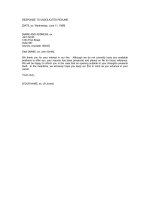Response to literature
Bạn đang xem bản rút gọn của tài liệu. Xem và tải ngay bản đầy đủ của tài liệu tại đây (286.7 KB, 12 trang )
Response
to
Literature
Reacting to a literary work . . .
From Reading to Writing Stories such as
“The Scarlet Ibis” by James Hurst and poems
such as “My Papa’s Waltz” by Theodore
Roethke evoke strong emotional responses in
many readers.
Response
to
Literature
Reacting to a literary work . . .
Readers’ own memories and experiences often
affect their responses to stories and poems.
Analyzing your personal response to
literature can generate valuable insights about
your own life and the world around you.
Basics in a Box
Response to Literature at a Glance
Introduction
Introduces the literary work
and includes a clear thesis
statement that presents the
response
Writing
A successful response to
literature should
• include an introduction that
identifies the literary work and
clearly states your overall
response to it
Body
Supports the interpretation with evidence
from the literary work
RUBRIC Standards for
Explanation
Evidence
Evidence
Evidence
• tell enough about the literary
work so that readers can
understand your response
• contain clearly described,
specific reactions and
responses to the literary work
• support your statements with
quotations and details
Conclusion
Summarizes the response
• use language and details that
are appropriate for your
audience
Writing Your Response to Literature
1
Prewriting
Originality
Originality does
does not
not consist
consist in
in saying
saying what
what
no
no one
one has
has ever
ever said
said before,
before, but
but in
in saying
saying
exactly
exactly what
what you
you think
think yourself.
yourself.
Sir
Sir James
James F.
F.Stephen,
Stephen,
British
British journalist
journalist and
and judge
judge
Writing Your Response to Literature
1
Prewriting
In selecting a poem or story for your
response, recall characters with whom
you identify. Consider themes that make
you think about your own life. Focus on
settings that stimulated your
imagination. Remember a plot that
surprised or pleased you.
Planning Your Response to Literature
1. Carefully read the piece of literature. Take
notes on passages that affect you. Include
page numbers for your reference.
2. Freewrite about your responses. How did
you respond to the characters? theme? plot?
setting? style?
Planning Your Response to Literature
3. Consider how your own memories and
experiences affected your responses.
Have you had a similar experience? Does the
story’s theme coincide or clash with your own
beliefs? Do you know people like the story’s
characters?
4. Identify your audience. How familiar is your
audience with the work that you are
discussing? What will they need to know in
order to understand your response?
Writing Your Response to Literature
2
Drafting
■
Begin writing even if you have not decided
on everything you want to say.
■
Write an introduction that includes the title
and author of the work and summarizes
important information such as plot.
■
Begin the body by stating your general
response to the piece of literature. Then
explain why you felt as you did.
Writing Your Response to Literature
2
Drafting
■
Elaborate on your response by quoting or
summarizing specific passages. You may
also mention personal experiences that
affected your reading.
■
Summarize your response in the
conclusion of your essay.
Writing Your Response to Literature
3
Revising
TARGET SKILL
USING ACTIVE VOICE
To make your responses to the literary
work clear, use active voice whenever
possible. Frequent use of active voice
makes your writing stronger, livelier, and
less wordy.
Writing Your Response to Literature
4
Editing and Proofreading
TARGET SKILL
MISPLACED MODIFIERS
Express your ideas clearly by using
modifiers correctly. Always place a
modifier as close as possible to the word
it modifies. A misplaced modifier may
leave readers with an unclear
description.









